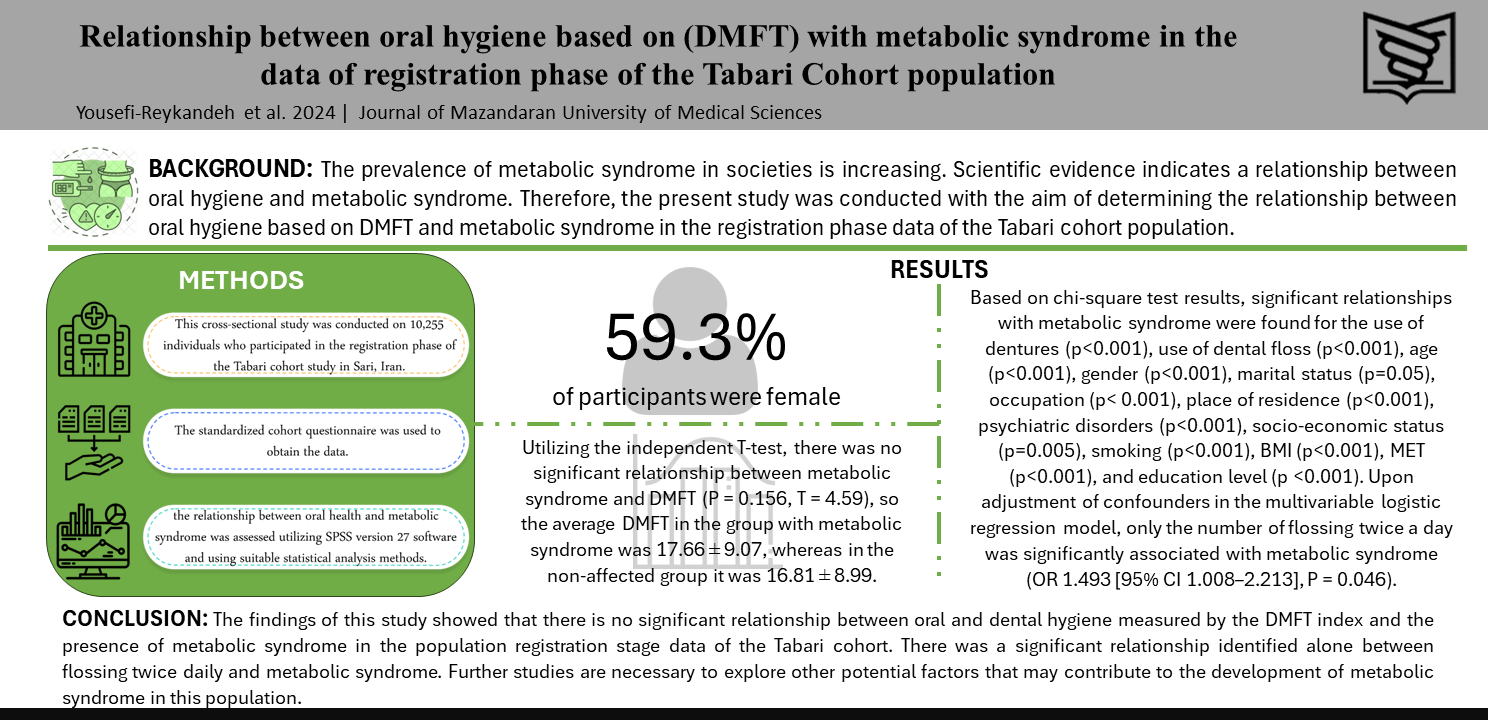Volume 34, Issue 233 (5-2024)
J Mazandaran Univ Med Sci 2024, 34(233): 73-83 |
Back to browse issues page
Download citation:
BibTeX | RIS | EndNote | Medlars | ProCite | Reference Manager | RefWorks
Send citation to:



BibTeX | RIS | EndNote | Medlars | ProCite | Reference Manager | RefWorks
Send citation to:
Yousefi-Reykandeh S S, Moosazadeh M, Kheradmand M, Hosseini A, Bagheri-Nesami M. Relationship between oral Hygiene Based on (DMFT) with Metabolic Syndrome in the Data of Registration Phase of the Tabari Cohort Population. J Mazandaran Univ Med Sci 2024; 34 (233) :73-83
URL: http://jmums.mazums.ac.ir/article-1-20664-en.html
URL: http://jmums.mazums.ac.ir/article-1-20664-en.html
Seyed Sajjad Yousefi-Reykandeh 
 , Mahmood Moosazadeh
, Mahmood Moosazadeh 
 , Motahareh Kheradmand
, Motahareh Kheradmand 
 , Amirsaeed Hosseini
, Amirsaeed Hosseini 
 , Masoumeh Bagheri-Nesami
, Masoumeh Bagheri-Nesami 


 , Mahmood Moosazadeh
, Mahmood Moosazadeh 
 , Motahareh Kheradmand
, Motahareh Kheradmand 
 , Amirsaeed Hosseini
, Amirsaeed Hosseini 
 , Masoumeh Bagheri-Nesami
, Masoumeh Bagheri-Nesami 

Abstract: (2001 Views)
Background and purpose: The prevalence of metabolic syndrome in societies is increasing. Metabolic syndrome is a cluster of medical conditions that include obesity, hypertension, dyslipidemia, and insulin resistance. Poor dental care is linked to numerous systemic disorders. Scientific research supports the presence of a relationship between oral hygiene and metabolic syndrome. Therefore, the present study was conducted to determine the relationship between oral hygiene based on DMFT (decayed, missing, filled teeth) and metabolic syndrome in the registration phase data of the Tabari cohort population.
Materials and methods: This study was cross-sectional and analytical and included participants from the Tabari cohort population who had performed oral health and metabolic syndrome assessments during the registration phase. Throughout the registration period of the Tabari cohort study (TCS), data was gathered from 10255 individuals ranging from 35 to 70 years old. This data was obtained from both urban and mountainous parts of Sari, Mazandaran, Iran, during the years 2015 and 2017. Data regarding education level, occupation status, residential location, socio-economic status, marital status, mental health history, smoking or hookah habits, daily physical activity, dental hygiene practices (such as tooth brushing and flossing frequency), denture usage and care, mouthwash usage, and DMFT index were gathered during the implementation of TCS through interviews and oral examinations. Metabolic syndrome was diagnosed based on the criteria of the third adult treatment panel (ATP III). Ultimately, SPSS version 27 software was utilized to describe the data using mean, standard deviation, and percentage. The qualitative variables were compared with the metabolic syndrome using the chi-square test, while the quantitative variables were compared using the independent t-test in univariate analysis. Furthermore, the process of adjusting for confounding variables was carried out through the utilization of multivariate logistic regression.
Results: 9,939 people were included in the final analysis. Independent T-test result showed that there was no significant relationship between metabolic syndrome and DMFT (P=0.156, T=4.59), so the average DMFT in the group with metabolic syndrome was 17.66±9.07, whereas in the non-affected group, it was 16.81±8.99. Based on chi-square test results, significant relationships with metabolic syndrome were found for the use of dentures (P<0.001), use of dental floss (P<0.001), age (P<0.001), gender (P<0.001), marital status (P=0.05), occupation (P<0.001), place of residence (P<0.001), psychiatric disorders (P<0.001), socio-economic status (P=0.005), smoking (P<0.001), BMI (P<0.001), MET (P<0.001), and education level (P<0.001). Upon adjustment of confounders in the multivariable logistic regression model, only the number of flossing twice a day was significantly associated with metabolic syndrome (OR 1.493 [95% CI 1.008–2.213], P=0.046).
Conclusion: The findings of this study showed that there is no significant relationship between oral and dental hygiene measured by the DMFT index and the presence of metabolic syndrome in the population registration stage data of the Tabari cohort. There was a significant relationship identified alone between flossing twice daily and metabolic syndrome. Further studies are necessary to explore other potential factors that may contribute to the development of metabolic syndrome in this population.
Materials and methods: This study was cross-sectional and analytical and included participants from the Tabari cohort population who had performed oral health and metabolic syndrome assessments during the registration phase. Throughout the registration period of the Tabari cohort study (TCS), data was gathered from 10255 individuals ranging from 35 to 70 years old. This data was obtained from both urban and mountainous parts of Sari, Mazandaran, Iran, during the years 2015 and 2017. Data regarding education level, occupation status, residential location, socio-economic status, marital status, mental health history, smoking or hookah habits, daily physical activity, dental hygiene practices (such as tooth brushing and flossing frequency), denture usage and care, mouthwash usage, and DMFT index were gathered during the implementation of TCS through interviews and oral examinations. Metabolic syndrome was diagnosed based on the criteria of the third adult treatment panel (ATP III). Ultimately, SPSS version 27 software was utilized to describe the data using mean, standard deviation, and percentage. The qualitative variables were compared with the metabolic syndrome using the chi-square test, while the quantitative variables were compared using the independent t-test in univariate analysis. Furthermore, the process of adjusting for confounding variables was carried out through the utilization of multivariate logistic regression.
Results: 9,939 people were included in the final analysis. Independent T-test result showed that there was no significant relationship between metabolic syndrome and DMFT (P=0.156, T=4.59), so the average DMFT in the group with metabolic syndrome was 17.66±9.07, whereas in the non-affected group, it was 16.81±8.99. Based on chi-square test results, significant relationships with metabolic syndrome were found for the use of dentures (P<0.001), use of dental floss (P<0.001), age (P<0.001), gender (P<0.001), marital status (P=0.05), occupation (P<0.001), place of residence (P<0.001), psychiatric disorders (P<0.001), socio-economic status (P=0.005), smoking (P<0.001), BMI (P<0.001), MET (P<0.001), and education level (P<0.001). Upon adjustment of confounders in the multivariable logistic regression model, only the number of flossing twice a day was significantly associated with metabolic syndrome (OR 1.493 [95% CI 1.008–2.213], P=0.046).
Conclusion: The findings of this study showed that there is no significant relationship between oral and dental hygiene measured by the DMFT index and the presence of metabolic syndrome in the population registration stage data of the Tabari cohort. There was a significant relationship identified alone between flossing twice daily and metabolic syndrome. Further studies are necessary to explore other potential factors that may contribute to the development of metabolic syndrome in this population.
Type of Study: Research(Original) |
Subject:
nursing
Send email to the article author
| Rights and permissions | |
 |
This work is licensed under a Creative Commons Attribution-NonCommercial 4.0 International License. |





